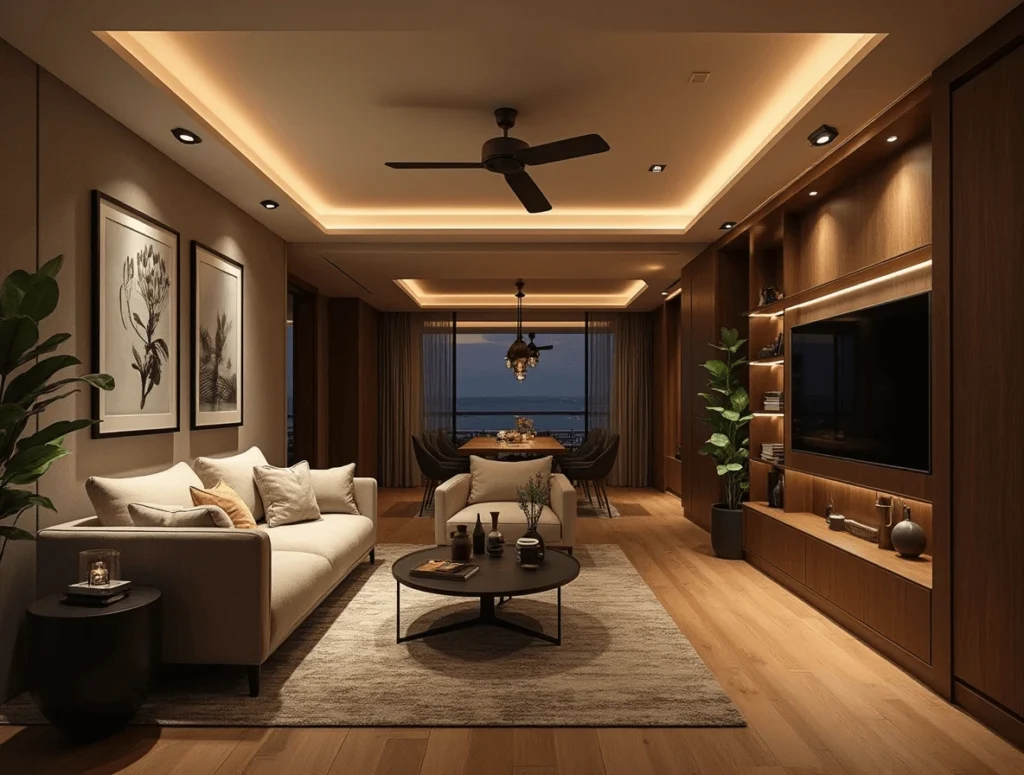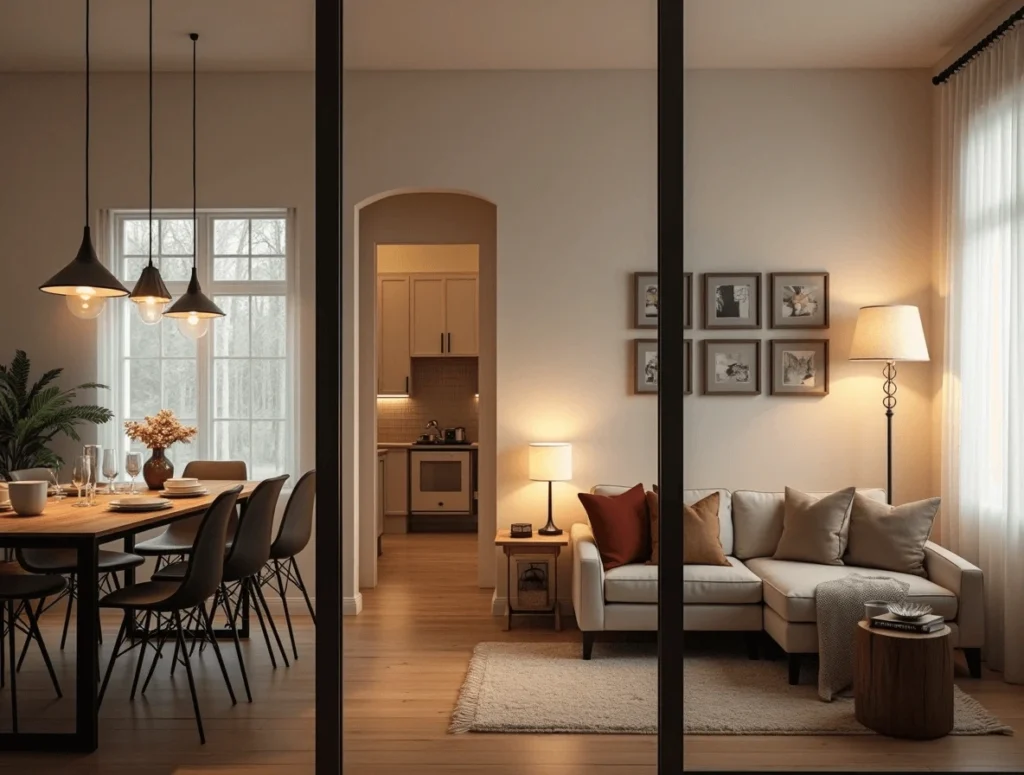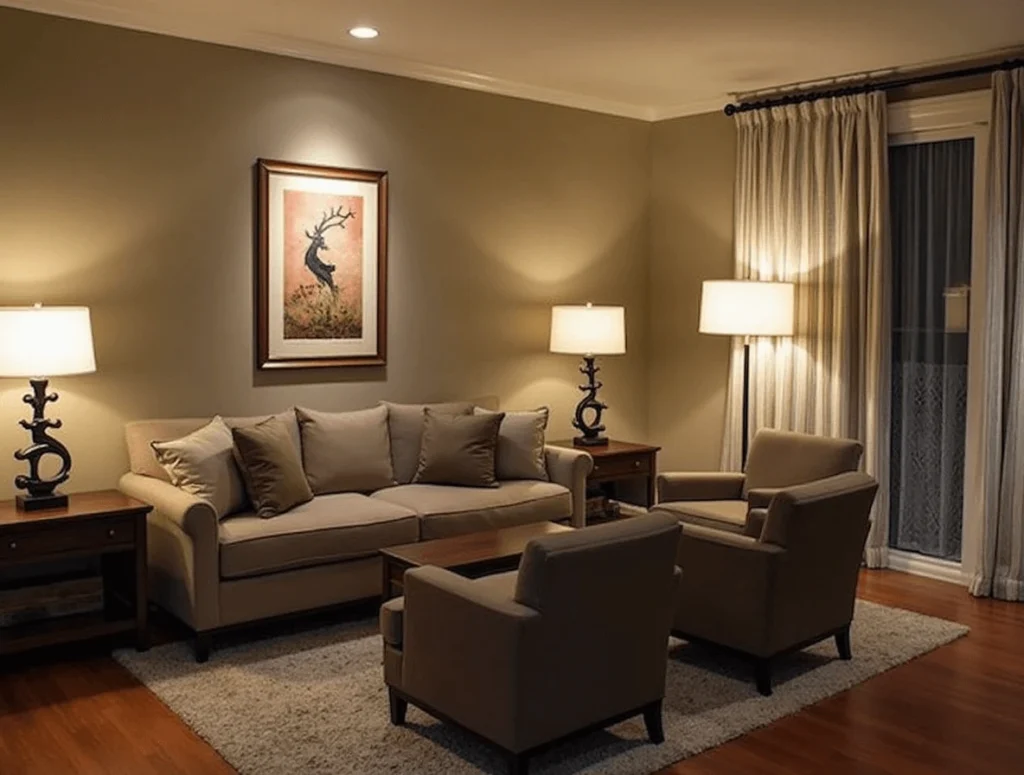Lighting plays a vital role in transforming your living spaces, offering both function and flair. This Room Lighting Guide provides actionable tips to help you achieve the perfect balance of brightness and style in every room. From selecting energy-efficient bulbs to mastering layered lighting techniques, the right choices can elevate your home’s ambiance and practicality.

Good lighting isn’t just about illuminating a room; it sets the mood, enhances your decor, and impacts your well-being. Whether you’re designing a cozy bedroom retreat or a vibrant kitchen workspace, this guide simplifies the process, combining expert advice with practical insights. Let’s get started on creating beautifully lit spaces that truly feel like home!
Lighting 101: The Foundation of a Well-Lit Home
Understanding the basics of lighting design is the first step in creating a home that is both functional and inviting. This Room Lighting Guide will walk you through the three main types of lighting and explain how they work together to form a cohesive and adaptable lighting plan. By mastering these essential elements, you can transform any room into a well-lit haven that meets your practical needs and showcases your style.
Understanding the Three Types of Lighting
Ambient Lighting: The Base Layer
Ambient lighting is the foundation of your Room Lighting Guide. It provides the general illumination that fills a room, ensuring it’s comfortable and functional. Think of it as the base layer of your home lighting design. Overhead fixtures, recessed lighting layouts, and strategically placed LED bulbs are common sources. The goal is to achieve even brightness without harsh shadows or areas of darkness.
Task Lighting: Enhancing Functionality
Task lighting serves specific purposes, such as illuminating areas where you need focused light for activities like reading, cooking, or working. In your Room Lighting Guide, you’ll discover how desk lamps, under-cabinet lighting, and pendant lights can serve as task lighting. Proper task lighting placement is key to minimizing glare and ensuring sufficient brightness for tasks, making your space functional and efficient.
Accent Lighting: Adding Personality and Style
Accent lighting in your Room Lighting Guide adds depth and character to your home. By highlighting architectural features, artwork, or décor, accent lighting draws attention to the room’s best elements. Common options include wall sconces, spotlights, or LED strip lighting. This style of lighting helps create a dynamic atmosphere and adds a sense of personality to your space.
Why Layering Lighting Matters
Layering lighting is an essential part of any Room Lighting Guide, allowing you to combine ambient, task, and accent lighting for versatility. For instance, a living room lighting design may include recessed lighting for general brightness, a floor lamp for task lighting, and dimmable lights to create a cozy evening ambiance. This layered approach provides flexibility and enhances your room’s atmosphere, making it adaptable to different needs and moods.
By carefully layering these types of lighting, you create a well-balanced lighting plan. Your home will be beautifully lit and fully functional, effortlessly catering to every task, occasion, and ambiance.
Tip 1: Choose the Right Fixtures for Each Room
Choosing the right fixtures is key to creating a well-lit, functional home. In this Room Lighting Guide, we’ll explore how to select lighting fixtures that suit the needs of each room, whether you’re designing a cozy living room or a bright kitchen.

Matching Fixtures to Room Functionality
Each room requires different lighting depending on its purpose. For instance, your living room lighting design should offer a balance of ambient and task lighting, while a home office may need more focused illumination.
Ceiling-Mounted Lights for General Illumination
Ceiling-mounted lights provide overall brightness for large areas. Recessed lighting or flush-mount ceiling fixtures work well to create even, general illumination in spaces like hallways or living rooms.
Pendant Lights for Dining and Kitchen Areas
Pendant lights are perfect for the kitchen or dining room, where they provide both functional task lighting and style. They’re great for illuminating countertops or dining tables, especially when paired with dimmable lights.
Portable Lamps for Flexibility
Table or floor lamps offer flexible lighting, allowing you to add task lighting wherever needed. They’re ideal for spaces like the bedroom or living room and can easily be repositioned.
Exploring Fixture Styles: Modern, Classic, and Rustic
Choose fixtures that match your room’s aesthetic. Whether modern, classic, or rustic, the right style complements your home’s decor while adding functionality.
Tip 2: Select the Best Bulbs for Your Space
Selecting the right bulbs is essential for creating the perfect atmosphere in your home. In this Room Lighting Guide, we’ll help you choose the best bulbs to complement your lighting design, from efficiency to mood.
Comparing Bulb Types: LED, Incandescent, CFL, and Halogen
LED bulbs are the most energy-efficient and long-lasting, making them the top choice for home lighting design. Incandescent bulbs offer warm light but are less efficient, while CFLs provide a good balance of efficiency and cost. Halogen bulbs are bright but use more energy.
Understanding Brightness and Efficiency
To choose the right bulb, focus on lumens (brightness) rather than wattage (energy use). Higher lumens give you more light without increasing energy consumption. A 10-watt LED, for example, can be just as bright as a 60-watt incandescent lightbulb.
How Color Temperature Impacts Mood
The color temperature scale, ranging from warm to cool, affects the room’s ambiance. Warm light (2700K-3000K) is cozy for bedrooms, while neutral (3500K-4100K) works well in kitchens. Cool light (5000K+) is ideal for task lighting in offices.
By selecting the right bulbs based on efficiency, brightness, and color temperature, you can enhance your Room Lighting Guide and create the perfect ambiance in every room.
Tip 3: Master the Art of Lighting Placement
In this Room Lighting Guide, we’ll show you how to perfect the placement of your lights to create a well-lit and functional space. Strategic lighting placement can dramatically improve your home’s ambiance and usability.
Drafting a Lighting Layout Plan
Start by drafting a layout plan for your room. Take into account the floor plan, furniture arrangement, and fixed elements like windows. This helps you identify where lighting is most needed.
Floor Plans, Furniture, and Fixed Elements
Position lights based on how you use the room. For example, in a kitchen, under-cabinet lighting is great for work areas, while pendant lights over the island add style. Ensure lights aren’t blocked by furniture.
Avoiding Shadows and Glare
When planning your lighting, avoid placing lights too close to reflective surfaces to minimize glare. Instead, position lights at angles that enhance the room’s ambiance without creating harsh shadows.
Practical Examples for Kitchens, Bedrooms, and Living Rooms
In the living room, use a mix of ambient and accent lighting to create depth. In bedrooms, bedside lamps offer targeted light, improving bedroom lighting ambiance.
Related article : 10 Best Guest Bedroom Decor Ideas to Wow Your Visitors
By following these lighting placement strategies, you can create a functional and well-balanced lighting scheme.
Tip 4: Optimize Your Lighting with Controls
In this Room Lighting Guide, optimizing your lighting with the right controls can elevate your home’s functionality and ambiance. By integrating lighting controls like dimmers and smart systems, you can create an adaptable, energy-efficient lighting setup that suits every situation.
Benefits of Dimmers in Lighting Design
Dimmers are a game-changer in home lighting design. By adjusting the brightness, they let you tailor the lighting to different moods and activities. Whether you’re hosting guests or enjoying a quiet evening, a dimmer switch offers flexibility in creating the perfect environment.
Adjusting Brightness for Different Activities
For tasks like reading or cooking, brighter lighting works best. However, for relaxation or entertaining, dimming the lights can create a cozy, inviting atmosphere. Dimmers are also energy-efficient, helping reduce energy usage by lowering the brightness when full illumination isn’t needed.
Exploring Smart Lighting Systems
Smart home lighting allows you to control your lights remotely, even when you’re not at home. Through apps or voice assistants, you can adjust your lighting to match your schedule and preferences.
Motion Sensors, Timers, and Voice-Controlled Systems
Integrating motion sensors and timers into your lighting setup adds convenience and efficiency. Smart lighting can also be voice-controlled, making it an ideal solution for busy households or smart home enthusiasts.
Optimizing your lighting controls enhances both convenience and ambiance in your space.
Tip 5: Customize Your Lighting for Personality
Your home’s lighting should reflect your unique personality and style. In this Room Lighting Guide, we’ll explore how to use lighting to showcase your tastes and create a welcoming environment that feels truly yours.

Using Accent Lighting to Highlight Features
Accent lighting is a fantastic way to emphasize key features in your space. Whether you want to spotlight a piece of art, a stunning architectural detail, or a beautiful plant, accent lighting adds depth and character to your room.
Art, Architectural Details, and Focal Points
To highlight a focal point, use adjustable spotlights or track lighting. This draws attention to specific areas, enhancing their presence in the room. Consider using dimmable lights to adjust the intensity of the accent, depending on the time of day and mood you want to create.
Choosing Fixtures That Reflect Your Style
Lighting fixtures do more than illuminate—they act as statement pieces. Choose pendant light styles, chandeliers, or sconces that complement your room’s decor. Whether your style is modern, rustic, or industrial, the right fixture can bring your vision to life.
Adding a Personal Touch with Decorative Elements
Personalize your space further by incorporating unique decorative lighting elements. From colorful lampshades to vintage bulbs, these details can help you express your personality while maintaining functional lighting.
By customizing your lighting, you not only enhance the atmosphere but also make your home feel like an extension of your own style and character.
Energy Efficiency and Sustainability in Lighting
When it comes to optimizing your lighting design, energy efficiency is key. In this Room Lighting Guide, we’ll explore how to make sustainable choices that reduce energy consumption and enhance your space’s ambiance.
Why Energy-Efficient Lighting Matters
Energy-efficient lighting is essential for both saving on electricity bills and reducing your environmental footprint. By making eco-conscious choices, you can achieve a home lighting design that’s both beautiful and sustainable. Switching to LED bulbs, for example, can save up to 75% of the energy compared to traditional incandescent bulbs while lasting much longer.
The Environmental Impact of LEDs vs. Traditional Bulbs
When evaluating lighting options, LEDs come out on top. Unlike incandescent and CFL bulbs, LEDs consume far less energy and have a longer lifespan. This makes them a vital part of any room lighting guide, providing eco-friendly solutions without sacrificing light quality or style.
Tips for Reducing Your Energy Costs
There are simple ways to reduce your energy consumption while keeping your home well-lit. For example, consider adding dimmable lights to your room lighting design. This allows you to adjust brightness based on your needs, ensuring that you’re never using more energy than necessary.
Smart Bulbs and Automation for Savings
Smart home lighting is a game-changer when it comes to energy savings. By integrating smart bulbs into your lighting placement strategy, you can control them remotely, schedule them to turn off when not in use, and adjust brightness based on the time of day or activity, all of which help you cut down on energy usage.
Future Trends in Sustainable Lighting
The future of room lighting design looks brighter and greener. From solar-powered lights to next-generation LEDs, the lighting industry continues to evolve toward even more energy-efficient solutions. By staying on top of trends, you can ensure your lighting is always sustainable, stylish, and functional.
By following the tips in this Room Lighting Guide, you’ll not only create an efficient lighting setup but also make a positive impact on the environment.
Conclusion
In this Room Lighting Guide, you’ve learned essential tips to elevate your lighting design, from layering your lights to selecting energy-efficient bulbs and mastering lighting placement strategies. Whether you’re aiming to create the perfect ambiance in your living room or experimenting with smart home lighting systems, the key is to combine functionality with style. Don’t hesitate to explore different lighting fixtures, including dimmable options and accent lighting ideas, to reflect your personal taste. With these expert tips, you now have the knowledge to transform your space into a well-lit, inviting environment. So, use this guide as a foundation and have fun experimenting to create lighting that truly enhances your home!
